The Case Of The Missing Channel
The cable channel Genesis StoryTime aired in numerous homes in the U.S. and Canada. Yet few records of it exist online. Here's our attempt to fix that.
Hey guys, Ernie here with an epic find from Andrew Egan. He worked really hard on this one and I wanna give him a ton of credit here. Strap in for an epic piece.
Sponsored By … You?
If you find weird or unusual topics like this super-fascinating, the best way to tell us is to give us a nod on Ko-Fi. It helps ensure that we can keep this machine moving, support outside writers, and bring on the tools to support our writing. (Also it’s heartening when someone chips in.)
We accept advertising, too! Check out this page to learn more.
1.3M
The number of subscribers that had access to the cable network Genesis StoryTime at its peak. The silent TV station aired computer generated versions of children’s books in the 1980s.
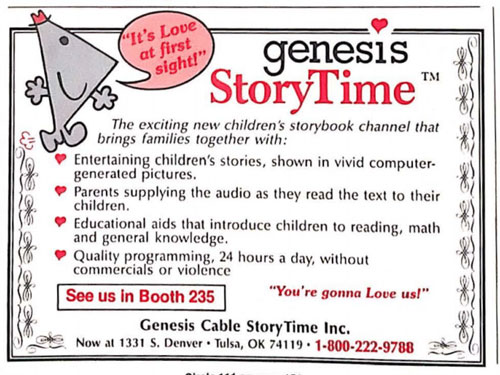
An ad for Genesis StoryTime that ran in the February 1, 1984 edition of Cable Television Business, a trade publication. The channel was based in Winnipeg but was at one point marketed in the U.S. out of an office in Tulsa, Oklahoma. (all pictures courtesy Barco Library at the Cable Center)
The innovative technology behind Genesis StoryTime almost caused the channel to fade from memory
The late 1970s and early 1980s were an exciting time for technology and communications. Engineers and programmers were racing to put new developments into use. Some were seeking to make the world a better place, while others were seeking their fortunes. Greg Stetski and Art Doerksen wanted to do a bit of both.
Genesis StoryTime debuted in 1982 to a small contingent of subscribers in western Canada. The brainchild of two Canadian engineers, Genesis StoryTime used a version of teletext to distribute children’s books. Describing the technology powering the channel can be challenging—it’s somewhat similar in nature to the technology used on the Prodigy computer network, an infamously hard-to-archive service—but comparing it to flight information monitors at airports is useful. A computer is used to display simple information over a variety of screens.
Versions of teletext technology, like Telidon, allowed for simple graphics and even crude animation. Some hail Telidon as a pioneer of the graphical web. Unfortunately, graphics were about all the technology had to offer. Sound wasn’t available. While some saw this as a limitation, Stetski and Doerksen saw an advantage.
“The channel was always intended to be silent,” Stetski says from his home in Manitoba, Canada. “We wanted to use television to bring parents and kids together.”
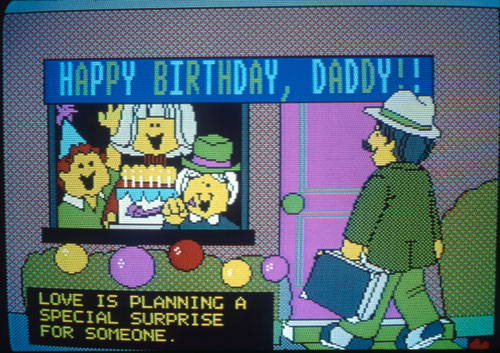
This screengrab is one of the few visual pieces of evidence that this channel existed.
Publishers were quick to jump into the project, and soon the channel had more than 300 stories. With a 90 words-per-minute read rate, stories typically ran from 10 to 15 minutes. While the majority of the content came from mainstream authors, like Roger Hargreaves of Mr. Men fame, about 10 percent were Bible stories. The decision to run the Bible stories was somewhat practical as the rights were in the public domain. However, Stetski kept them in rotation despite financial pressure to do otherwise.
“[One cable system owner] said if I got rid of the Bible stories he’d put us in every home in Florida,” Stetski recalled. Still, he kept the faith.
The channel steadily grew to reach at least a million subscribers, but Greg said they hit between two and three million at one point. Despite fairly widespread popularity, footage of Genesis StoryTime is incredibly difficult to come by. It was never intended to be recorded then played. What aired was a computer program generating a series of coordinated graphics and text. As a result, there are almost no long-lost VHS copies. Nothing to upload to YouTube.
One writer referred to footage of Genesis StoryTime as a “pop culture ghost.“ Even the Barco Library at the Cable Center, an archive dedicated to the preservation of audiovisual resources and equipment exclusive to the cable and media industry, only has still images of Genesis StoryTime.
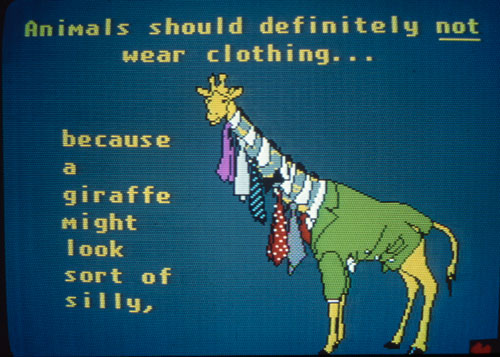
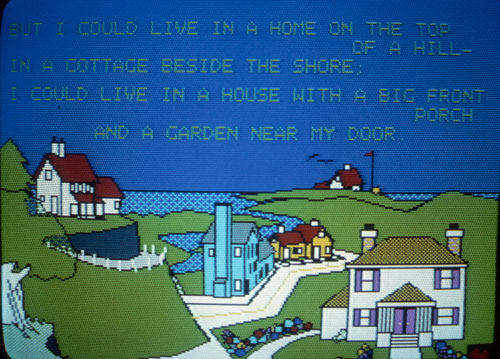
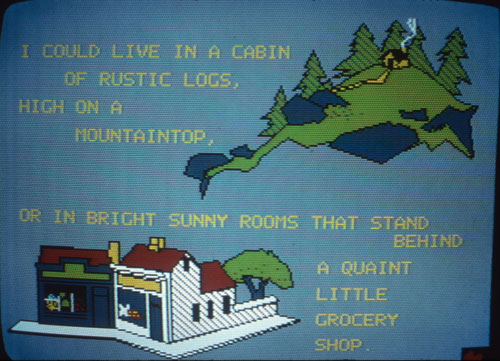
A few other examples of what the channel looked like back in the day.
This ineffability seemed to translate to the Genesis Research Corporation, the company behind Genesis StoryTime. By 1990, the company was on its last legs when the owner of a Winnipeg commercial real estate firm swooped in to save the day.
“We had come to a place where we needed someone else to come take it over,” Stetski said to the Winnipeg Free Press in 1990. “We were on the verge of shutting it down and that’s when Helmut came on the scene.”
Helmut Sass purchased Genesis Research Corporation after seeing StoryTime while on vacation in the U.S. His intentions for the company weren’t profit oriented, saying, “My motive isn’t so much to make money in this, but to provide wholesome stories for children again.”
The timing of the transition also provided an opportunity for Art Doerksen to change his life. “He gave me all his parkas and winter boots and moved to Vancouver!” Stetski said, laughing. Though the two remained friends, Doerksen wouldn’t be involved in the next iteration of Genesis StoryTime, known as Story Vision Network, and rarely returned to Winnipeg.
“He wanted to use his skills to help people,” Stetski said.
Greg attributes much of their success to Doerksen, and called him “one of the best engineers in Canada”.
Story Vision Network wouldn’t fare much better than Genesis, with the channel ceasing operations in the late 1990s. Stetski had moved on, finding a new passion helping to spread the Gospel. He became a preacher and executive director of the Union Gospel Mission Winnipeg, a post he only recently retired from.
He would also go on to continue the work of Genesis StoryTime, albeit in a different form. Since he still retained the rights to the Bible stories, he began distributing them as PDFs to churches and youth groups around the world. His organization, Bible for Children, now offers 60 Bible stories in dozens of languages. The nonprofit is even on the App Store and Google Play.
While Greg found a pious path forward after his life as a television executive, Art Doerksen would choose to help people in a very strange way.
Zappers are “medical” devices that are purported to kill “parasites, bacteria, viruses” and other forms of tiny bugs that proponents say cause cancer and a host of other ailments. Though the exact timing is uncertain—we can find digital records going far back as 1998, and he says his use of zappers predated even that date—Doerksen got involved in the design and marketing of zappers around the time of his second cancer diagnosis.
In a lengthy testimonial published on a zapper sales website, Art described how the device, along with healthy eating habits, helped him beat two separate cancer diagnoses. After describing his misgivings with conventional cancer treatments, Art writes, “An effective alternative was needed, and we chose to build up my immune system rather than let the surgeon attack it. We committed my health into God’s hands in prayer, and I began taking 10 grams of Vitamin C a day …”
Greg didn’t comment on his friend’s belief in alternative medicine, but did offer this: “He became interested in healthy eating, and then he became convinced that zappers would help people.”
When you watch clips of Art evangelizing zappers, it does come across as sincere. And not like fake televangelist sincerity. Art clearly put his faith in zappers and healthy eating as positive to his health. Art also wanted to use his engineering talents to help people. “He designed probably the best zapper there is, regarding the electrical components,” Greg added. The two remained friends until Doerksen’s death in 2016.
The men behind Genesis StoryTime leave a strange legacy. Their work was innovative and somewhat popular. Stetski noted that Genesis StoryTime was receiving two to three hundred letters a month from children requesting stories or generally just saying they liked the channel. However, evidence of their endeavour is scant, relegated to newspaper clips and the occasional blog bemoaning the lack of footage. Greg Stetski is better known as a pastor. Art Doerksen is better known for his advocacy of alternative medicine.
Maybe that sense of an adventure being forgotten encouraged Greg to answer questions about Genesis and his friend. For whatever reason, he did. And he did one better: Greg reached deep into his archives and resurrected a ghost.
As near as we can figure, this is the only known footage of content from Genesis StoryTime on the internet.
Percy Shelley couldn’t see the forest for the trees. At least that statue still existed. Sometimes we only get fleeting glimpses of something that was once great. That doesn’t make those subjects any less important or fascinating.
Locating even a brief glimpse of Genesis StoryTime was no small effort. It took research and patience that writers and bloggers aren’t typically capable of. We reached out to niche YouTube channels and specialty archives. We even called the Christian Broadcasting Network because there was a tip they had aired some of the Bible stories, but weren’t attached to the main Genesis system—in other words, they had tapes. None of it panned out. And as we waited and looked, we learned more and more about the channel and the men that sweated through to make it a reality. Then we learned what happened after it failed.
The story behind Genesis StoryTime is long and winding and would probably take 100,000 words to tell in its entirety. But at its core is the struggle between legacy, permanence, and even mortality. All of it from a silent Canadian TV cable channel.
:format(jpeg)/2018/04/tedium040518.gif)
/2018/04/tedium040518.gif)


/uploads/andrew_egan.jpg)